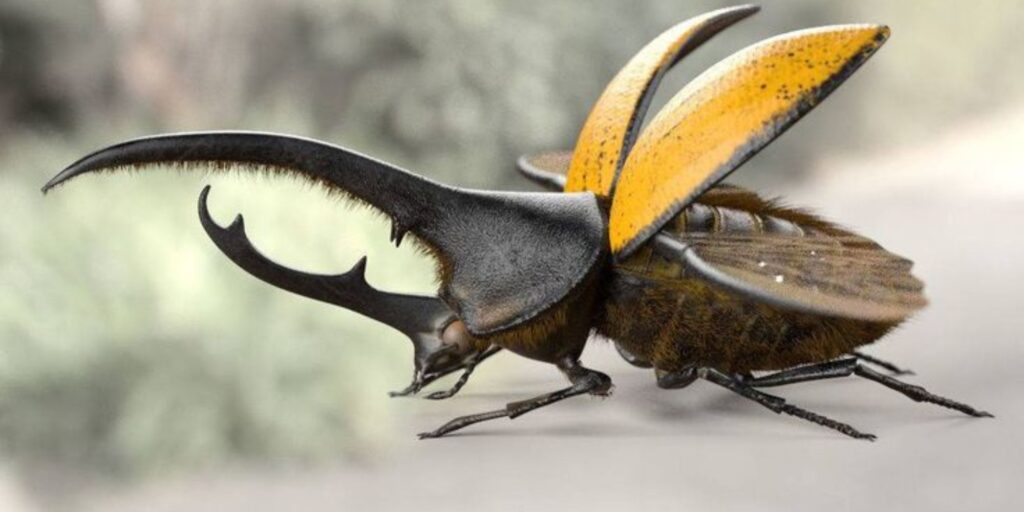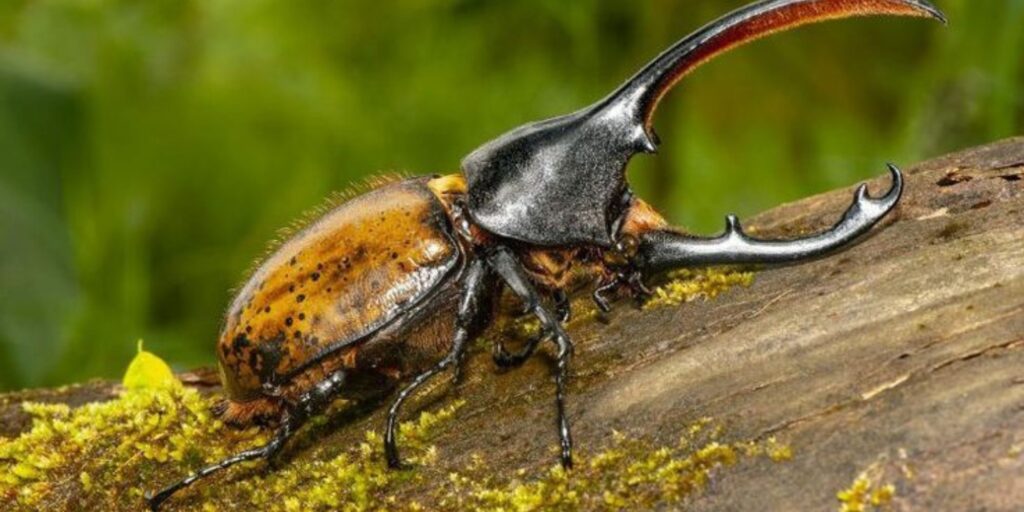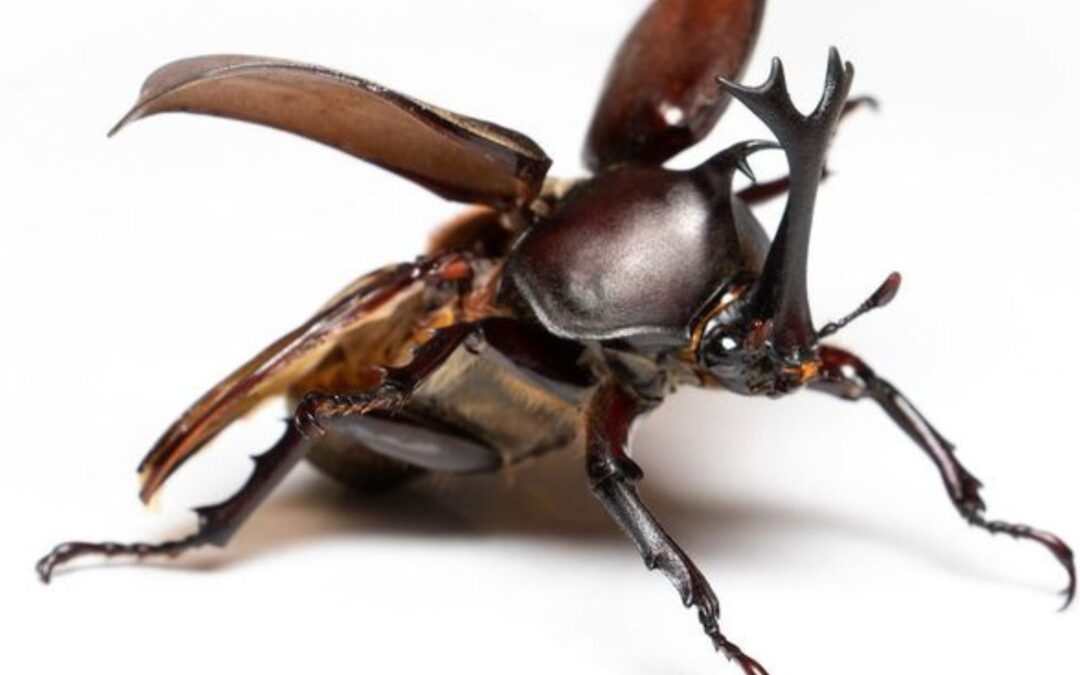Imagine a creature that embodies strength and beauty, with an armored exterior and unique features. This is the Japanese rhinoceros beetle, nature’s fascinating warrior. Renowned for its impressive horns and vibrant colors, this insect captivates enthusiasts worldwide. Its remarkable adaptations allow it to thrive in various environments while showcasing intriguing behaviors that reveal much about its life cycle. Join us as we delve into the captivating world of the Japanese rhinoceros beetle—an extraordinary marvel of nature!
Unveiling the Japanese Rhinoceros Beetle: Nature’s Armored Warrior

The Japanese rhinoceros beetle is a striking insect, easily recognized by its impressive horns and robust body. These features enhance its visual appeal and play crucial roles in mating rituals and territorial disputes among males.
Found primarily in Japan, these beetles thrive in diverse habitats, from lush forests to suburban gardens. Their adaptability allows them to flourish alongside humans while captivating the hearts of many with their unique charm and resilience.
Japanese Rhinoceros Beetle: Description
The Japanese rhinoceros beetle stands out with its impressive size and striking appearance. Ranging from 3 to 8 centimeters long, the males boast a prominent horn that adds to their warrior-like charm.
These beetles exhibit a glossy black or deep green coloration, making them visually captivating. Their robust bodies are designed for strength and endurance, giving them an armored look that perfectly suits their name. Nature certainly crafted these creatures as formidable fighters in the insect world.
Japanese Rhinoceros Beetle: Geographic Range
The Japanese rhinoceros beetle is primarily found in Japan, inhabiting various island regions. Its presence extends from Honshu to Kyushu, and it thrives in diverse environments.
These beetles are also spotted in parts of Southeast Asia. Countries like Taiwan and South Korea have reported sightings. Their broad geographic range showcases their adaptability to different habitats while still retaining a strong connection to their native lands.
Japanese Rhinoceros Beetle: Habitat
The Japanese rhinoceros beetle thrives in diverse habitats, primarily in forests and woodlands across Japan. These environments provide ample resources for their growth and reproduction.
They prefer areas rich in decaying wood, which supports their larvae during development. Adult beetles often inhabit gardens and parks where they can easily access food sources like tree sap and ripe fruit. This adaptability allows them to flourish throughout various landscapes.
Japanese Rhinoceros Beetle: Life Cycle

The life cycle of the Japanese rhinoceros beetle is a fascinating journey. It begins as an egg laid in moist soil or decaying wood.
After hatching, the larvae emerge and spend several months feeding on organic matter. This stage is crucial for their growth before they transform into pupae. Eventually, they metamorphose into adult beetles, ready to roam the forest floor for mates and food. Each phase plays a vital role in their survival strategy.
Japanese Rhinoceros Beetle: Larval Behavior
The larval stage of the Japanese rhinoceros beetle is fascinating. After hatching, they burrow into decaying wood or organic matter. This habitat provides essential nutrients for their growth.
These larvae exhibit a unique behavior by actively feeding on decomposing material. As they mature, they undergo multiple molts, gradually increasing in size and developing distinctive features that will serve them well in adulthood. Their underground life plays a crucial role in nutrient cycling within their ecosystems.
Japanese Rhinoceros Beetle: Genetics
The genetics of the Japanese rhinoceros beetle are fascinating. These insects exhibit considerable genetic diversity, contributing to their unique adaptations and survival strategies.
Researchers have identified specific genes that influence traits such as size and horn development. This genetic variation significantly affects their evolutionary success, helping them thrive in various environments across Japan. Understanding these genetic mechanisms offers insight into how they adapt to changing conditions.
Japanese Rhinoceros Beetle: Physiology
The Japanese rhinoceros beetle boasts a fascinating physiology that makes it stand out among insects. Its robust exoskeleton, designed for protection and durability, is adorned with striking colors—deep greens and blacks that shimmer in the sunlight.
These beetles possess powerful mandibles, ideal for battling rivals during mating seasons. Additionally, their impressive horns serve not just as weapons but also attract potential mates. This combination of features truly exemplifies nature’s design prowess.
Japanese Rhinoceros Beetle: Mating
Mating among Japanese rhinoceros beetles is a fascinating spectacle. The males engage in fierce battles to win the attention of females, showcasing their impressive horns and strength. These contests can be quite dramatic, with combatants locking horns and pushing each other.
Once a male secures his mate, he must still impress her. Courtship behaviors include ritualized displays and pheromone signaling, helping females select partners based on genetic fitness and physical attributes. This ensures healthy offspring for future generations.
Sexual Selection
Sexual selection plays a vital role in the life of the Japanese rhinoceros beetle. Males often display their formidable horns and size to attract females, showcasing fitness and genetic superiority.
These remarkable traits can lead to intense competition among males. Those with larger, more impressive horns tend to gain an advantage in mating opportunities. This dynamic creates a fascinating arena where physical characteristics directly influence reproductive success within this species.
Sexual Dimorphisms
Sexual dimorphism is striking in the Japanese rhinoceros beetle. Males boast impressive horns, which can vary significantly in size and shape. These adaptations are crucial for their role during mating competitions.
In contrast, females lack these prominent features, making them smaller and more streamlined. This difference not only aids males in battles but also enhances their appeal to potential mates. The distinct physical traits illustrate nature’s fascinating approach to survival and reproduction among this unique species.
Intra-Species Competition
Intra-species competition among Japanese rhinoceros beetles can be fierce. Males often engage in head-to-head combats, using their impressive horns as weapons. These battles determine dominance and access to mating opportunities.
During the breeding season, larger males tend to prevail over smaller rivals. This selective pressure contributes to the evolution of size and strength within populations, ensuring that only the fittest pass on their genes. Such dynamics shape their social structure in fascinating ways.
Feeding Resources
The Japanese rhinoceros beetle primarily feeds on tree sap, a nutrient-rich resource that provides the energy needed for growth and reproduction. The beetle’s strong mandibles help it access this vital food source, allowing it to thrive in its environment.
In addition to tree sap, they also consume decaying plant matter. This diet not only supports their development but also plays a role in nutrient recycling within their ecosystem. These feeding habits showcase their adaptability and ecological significance.
Interactions with Humans
The Japanese rhinoceros beetle has fascinated humans for centuries. In Japan, these striking insects are often kept as pets, and they are admired for their strength and unique appearance. Enthusiasts breed them in specially designed enclosures, sometimes investing significant time and money.
Moreover, they play a role in cultural practices and festivals. The beetles symbolize courage and tenacity. Their presence in various art forms reflects the deep connection between nature and human creativity, making them cherished symbols of resilience.
Bark-Carving Behavior
The Japanese rhinoceros beetle exhibits a fascinating bark-carving behavior that plays a crucial role in its life. Males often carve intricate patterns into the bark of trees, creating small tunnels and grooves.
This activity not only aids in establishing territory but also attracts potential mates. The carved structures serve as visual displays, showcasing strength and skill to other males and females, making it an essential part of their mating rituals and social interactions.
Chemical Cues
The Japanese rhinoceros beetle uses chemical cues to communicate and navigate its environment. These pheromones help them find mates and establish territory.
These olfactory signals play a crucial role in their social interactions. By detecting specific scents, they can identify kin or competitors, influencing their behavior significantly within the species.
Burrowing
Japanese rhinoceros beetles are skilled burrowers, using their strong legs to excavate soil. This behavior provides shelter from predators and extreme weather conditions.
Burrowing also plays a critical role in their life cycle. Larvae develop underground, where they consume decaying organic matter. This nutrient-rich environment supports healthy growth, ensuring these armored warriors thrive beneath the surface before emerging as adults.
Male-Male Interactions
Male Japanese rhinoceros beetles often engage in fierce battles for dominance. These contests can involve grappling, pushing, and flipping one another over. Size plays a critical role; larger males tend to have the advantage.
However, not all interactions lead to direct conflict. Some males display sneak-like behavior, attempting to mate with females while competitors are distracted. This strategic approach highlights the complexity of their social dynamics and mating strategies within their environment.
Sneak-Like Behavior
The Japanese rhinoceros beetle exhibits fascinating sneak-like behavior, especially during mating season. Males often employ stealth tactics to avoid confrontations with larger rivals while seeking females.
These clever strategies include quietly approaching potential mates without attracting attention. By blending into their surroundings or using cover, they gain a competitive edge in securing a partner, demonstrating that sometimes subtlety trumps brute strength in the animal kingdom.
Female-Female Interactions
Female Japanese rhinoceros beetles exhibit interesting behaviors when interacting with each other. These interactions can range from subtle greetings to more aggressive displays. Females often assess one another’s size and condition, which plays a role in resource competition.
Females sometimes confront males over prime feeding spots or suitable breeding areas. Such encounters can influence their reproductive success and the overall dynamics within their populations, showcasing the complexity of social behavior among these fascinating insects.
Research Applications
The Japanese rhinoceros beetle has captured the interest of researchers in various fields. Its unique physiology and behavior make it an excellent model organism for studying evolution, genetics, and ecology.
Moreover, scientists explore its potential applications in biomimicry and robotics design. The beetle’s strength and stability could inspire innovative technologies, influencing engineering and medicine industries. These research avenues highlight the fascinating intersections between nature and human advancement.
Use in Medicine
The Japanese rhinoceros beetle has garnered attention for its potential medicinal properties. Researchers are investigating the compounds within their exoskeletons and secretions, which may hold promise in treating various ailments.
Some studies suggest that these beetles possess anti-inflammatory and antibacterial qualities. This opens up new avenues for developing natural remedies inspired by nature’s armored warrior, showcasing how even small creatures can contribute to significant medical advancements.
Anti-Prion Activity
Recent studies have unveiled the intriguing anti-prion activity of the Japanese rhinoceros beetle. This remarkable insect possesses unique proteins that show potential in combating prion diseases, which affect both animals and humans.
Researchers are exploring how these proteins can inhibit prion replication. The possibility of harnessing this natural defense mechanism opens new avenues for medical research and therapeutic applications against neurodegenerative disorders caused by misfolded proteins. Nature’s solutions, such as this armored warrior, often come from unexpected places.
Akihabara Culture
Akihabara, known as the mecca for otaku culture, has uniquely embraced the Japanese rhinoceros beetle. These insects often appear in merchandise and themed cafes, captivating visitors with their armored appearance and toughness.
The fascination extends to live events where enthusiasts can compete by showcasing their prized beetles. This blend of nature and pop culture highlights these creatures’ deep interconnectedness within Japan’s vibrant urban landscape. In Akihabara, the beetle becomes a symbol of strength and resilience.
As a Food Resource

The Japanese rhinoceros beetle is captivating in its natural habitat and plays a unique role as a food resource. In some regions, these beetles are consumed for their nutritional value and taste. They are often seen in dishes that highlight local culinary traditions.
Their high protein content makes them appealing to those exploring alternative diets. As global interest in sustainable eating grows, the Japanese rhinoceros beetle may find itself more frequently on menus worldwide. This shift could redefine perceptions of insects as mere curiosities or pests, showcasing their potential benefits to human health and nutrition. Embracing this armored warrior might open new avenues for gastronomy and conservation efforts.

